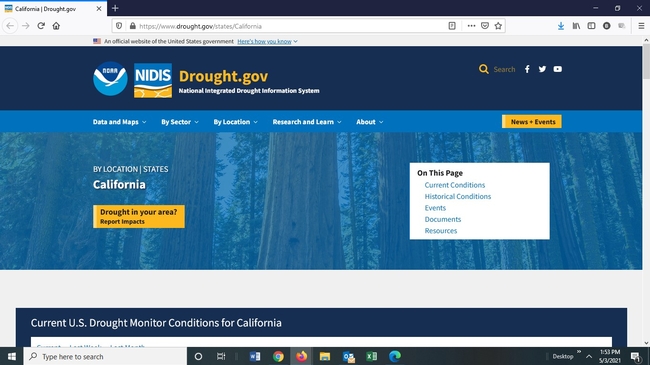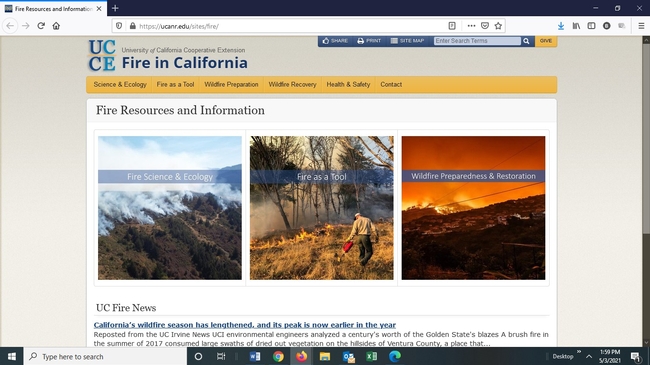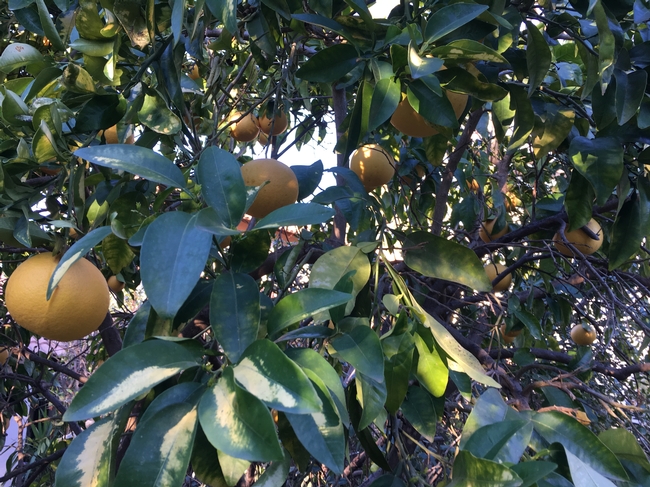
Posts Tagged: drought
Connecting to the Changes Around Us
Get Ready to learn more about our fragile world
and how to deal with drought, heat, fire, winds
and climate change
https://www.drought.gov/states/California
And a lot more information on fire, water and climate change
https://ucanr.edu/News/For_the_media/Press_kits/
Heat Forecast - Be Ready
From Fox Weather by way of CA Avocado Commission, hot weather is forecast for mid- to late- June
This is a time to make sure that trees are adequately hydrated prior to the heat spell. Once trees start losing water through transpiration, it's hard for them to absorb water and heat stress and sunburn damage can result. The trees need to be fully water, so that they can continue to transpire to cool themselves during the heat spells.
READ MORE:
https://ucanr.edu/blogs/blogcore/postdetail.cfm?postnum=29992
https://ucanr.edu/blogs/blogcore/postdetail.cfm?postnum=29933
https://ucanr.edu/blogs/blogcore/postdetail.cfm?postnum=27914
And don't forget people in the field:
- Be sure shade is available on demand when the temperature is below 80 degrees F, shade must be provided at all times when the temperature exceeds 80 degrees F, as close as practicable to where employees are working;
- Shade must be provided to all employees on a rest or meal break,except those who choose to take a meal break elsewhere (editor's note: provision of shade as usual may not be consistent with social distancing recommended by various COVID-19 guidance; ag employers implementing heat illness shade requirements can ensure adequate shade consistent with social distancing requirements by staggering meal and rest breaks, but additional shade may be necessary);
- Fresh, pure, and suitably cool water must be made available in sufficient quantities (replenishment is permissible) to allow each employee to drink one quart per hour;
- Water is to be provided as close as practicable to location of work;
- Employees must be trained about heat illness and the Cal/OSHA Heat Illness Prevention (HIP) Standard before they work in conditions where they might be exposed to heat;
- Supervisors must be additionally trained in HIP compliance procedures, emergency responses, and ensuring effective communication to facilitate emergency response.
- A written copy of your HIP program in English and the language understood by the majority of the employees and be available to employees and Cal/OSHA inspectors on request — this is the most frequently-cited part of the HIP standard — and probably the most easily-avoided HIP citation!
- Remember: When temperatures exceed 95 degrees, employers must implement “high heat” procedures, including a mandatory 10 minute break every two hours (meal and rest periods can serve as these breaks, but if employees work beyond eight hours or waive meal or rest periods, you must still ensure the mandatory rest break occurs).
Cal/OSHA Heat Illness Prevention Guidelines
30-Day Weather Outlook for May 31, 2020, to June 22, 2020
Summary- The prevailing pattern is a high pressure ridge from N California westsouthwest or southwestward. Cold fronts coming S through California will tend to extend southwestward from southcentral-S California to the area SW – W of S California.
A long-lived pattern of troughing or low pressure will continue from southwest of Central California to about 25N then extend west toward Hawaii.
The MJO is showing a slow increase in activity over the next two weeks.
CFSDailyAI and CFSv2 suggest some rains primarily in northern California and the Sierras, and into Siskiyou Mountains and southern Oregon at times.
It is early for monsoonal showers and thunderstorms (TSTMS). However, the presence of upper lows may begin to bring tropical moisture northward into SOCAL and the Sierras, despite the lack of a usual summer monsoonal pattern.
Potential Dates of Precipitation (from Fox Weather's CFSDAILYAI system):
Salinas Valley-San Luis Obispo Co- S SierraNV:
Salinas Valley Showers: 6/2-3. Hot spells 6/4, 6/8-9, 6/11-12, 6/14-17, 6/22-27.
San Luis Ob/Edna: Hot spells 6/6, 6/9, 6/12, 6/15-17, 6/20-27th, 7/1.
Southern California Citrus/Avocado Area, San Luis Obispo Co to San Diego Co:
Southern California Citrus/Avocado Area: May 31-June 15.
Santa Barbara, Ventura to San Diego Co: No rainfall of consequence.
Hot spells:
Santa Barbara Co: 6/6, 6/12. 6/16-17th, 6/22-26th.
Ventura Co: Hot 6/16-17th, 6/22-26th.
San Diego/Orange: Hot 6/16-17, 6/22-26.
Summary – June 15 – July 15… In Northern and Central California, Hottest: 6/14-17, 6/22,27, 7/1-2.
San Luis Obispo Co... Hottest periods 6/15-17, 6/22-27.
Southern California… Shallow marine layer and hot inland. Hottest: 6/16-17, 6/22-26, 7/1-3.
Seasonal Outlook July 15 – August 31... Northern and Central California overall pattern…. Near normal rainfall (minimal). Above normal temperatures occur during all of July and all of August. Usual thunderstorms (TSTMS) in the central and N Sierra and Plateau.
Southern California: San Luis Obispo Co, Santa Barbara Co, and Ventura to San Diego Counties east through Los Angeles to San Bernardino, Riverside and Imperial Counties…. Our latest guidance is suggesting a hot period in N and Northcentral California during mid-July, but near normal behavior of the marine layer at the SOCAL coast and valley areas. Although cloud amounts should be about normal, temperatures will drift above normal due to warmer sea surface off SOCAL and Baja. Weak troughs and upper lows will intermittently develop and deepen the marine layer as is normal for summer.
Looking further ahead into Sept – Nov, Dry and persistently warmer than normal conditions develop during the late Sept through Nov Santa Ana season.
Alan Fox...Fox Weather, LLC
Copyright © 2020, Fox Weather, LLC, Used by permission.

heat damage to avocado leaves
A More Water Efficient Avocado?
Here's a pretty technical report of water efficiency in avocado - the amount of water it takes to make fruit. It looks like there might be some varieties that could produce more fruit with less water. It's a promising start to selecting a tree that could produce under the increasing drought conditions found in avocado growing areas.
Evaluation of leaf carbon isotopes and functional traits in avocado reveals water-use efficient cultivars
Plant water-use efficiency (WUE) describes the ratio of carbon gain to water loss during photosynthesis. It has been shown that WUE varies among crop genotypes, and crops with high WUE can increase agricultural production in the face of finite water supply. We used measures of leaf carbon isotopic composition to compare WUE among 24 cultivars of Persea americana Mill (avocado) to determine genotypic variability in WUE, identify potentially efficient cultivars, and to better understand how breeding for yield and fruit quality has affected WUE. To validate carbon isotope measurements, we also measured leaf photosynthetic gas exchange of water and carbon, and leaf and stem functional traits of cultivars with the highest and lowest carbon isotope composition to quantify actual WUE ranges during photosynthesis. Our results indicate large variation in WUE among cultivars and coordination among functional traits that structure trade-offs in water loss and carbon gain. Identifying cultivars of subtropical tree crops that are efficient in terms of water use is critical for maintaining a high level of food production under limited water supply. Plant functional traits, including carbon isotopes, appear to be an effective tool for identifying species or genotypes with particular carbon and water economies in managed ecosystems.
Read the article:
https://www.sciencedirect.com/science/article/pii/S0167880918301828

avocado fruit
Another Victim of Drought Stress
So, this image comes across with the question of what is going on. It's a grapefruit, but what is going on with the leaves? It's happening to two grapefruit side by side or two different ages. It's not affecting other citrus nearby, and not a grapefruit several hundred feet away. Nothing like insect damage. It's not a nutrient deficiency because it's not following a clear pattern. It doesn't look like a chimera, which is common in citrus, because it's only a few outer leaves. It doesn't fit the pattern of an herbicide. It wouldn't be a contact or a drift spray because is both veinal and interveinal, and not strongly one or the other, so it's not consistent with a soil-applied herbicide either.
A plant pathologist and an herbologist (weed specialist) both asked if there had been a change in light -Different light exposure or more drought stress. Was a nearby tree removed or somehow the tree got more exposure than previously? Citrus Specialist, Peggy Mauk, nailed it, though. She said this type of coloration is characteristic of ‘Star Ruby' grapefruit when it is water stressed. And this can occur when the tree is more exposed to wind or light which is what happened here when a nearby hedge was pruned. The other citrus being less affected by such obvious symptoms, although probably stressed, as well.

citrus leaf clearing 2
What Damaged the Citrus this Winter? Frost? Herbicide?
Something hit the citrus trees of Riverside in late December 2017. Some vandal spraying herbicide? It was too widespread. It was all over town, orchards and backyards. It was on the north and east sides of trees. It didn't happen in Ventura or Santa Barbara. It probably happened to a lot of other plant species, but our correspondent had eyes only for citrus.
It sure looks like it could have been a cold, freezing wind, but on closer consultation with our Citrus Specialist, Peggy Mauk who also directs the Agricultural Operations at UC Riverside – it was the demon wind. The Satan Wind. The Santa Ana that dried out the trees that had not gotten sufficient water to cool themselves and had dried out on the windward side of the tree and orchard. Burned, in effect. This is the side of the orchard that dries out the most. It's what's called the “clothes line” effect. The margins that dry first because of the greater exposure to wind, sun and usually lower humidity. In this case, way lower. And by the time the damage was noticed a week later, the winds had been forgotten. Expect more water stress in our future.

citrus dieback 2

citrus santa ana damage 1



